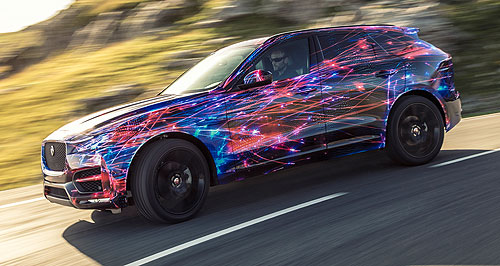Future models - Jaguar - F-PaceFrankfurt show: Jaguar F-Pace lifts its skirtsDon’t call it an SUV: Jaguar insists the F-Pace will be much more than a sports utility vehicle when it launches in Germany next month. Upcoming sports crossover to share suspension and platform with new XE27 Aug 2015 By TIM ROBSON JAGUAR has confirmed that its new F-Pace crossover will be underpinned by the same suspension system that has garnered high praise in the company’s new XE mid-size sedan. The front end, which is shared in part with the F-Type as well as the XE, will be supported via a double-wishbone layout with unequal-length control arms, with its dampers and springs arranged in a vertical strut layout. In the rear, the all-new multi-link arrangement from the XE – known as Integral Link in Jaguar-speak – is used. Jaguar engineers claim that the system – which separates the spring and dampers – allows the use of suspension bushes that can be up to 30 per cent softer than those in competitor cars. Lighter, thinner rising-rate springs are used front and rear, while both passive and active dampers are set to be offered across the range. Tenneco will supply the passive shocks, while all-new active dampers from Bilstein will be used. The F-Pace will only be available as a five-seater, which means that no modifications to the crossover’s rear underbody packaging are needed to accommodate a third row. Recycled alloy parts feature throughout to reduce the F-Pace’s unsprung mass, while the ZF-sourced motor-on-rack electric steering system from the XE – a first for Jaguar – will also be used in the F-Pace. The crossover will also inherit a bespoke version of Jaguar’s various chassis control systems, including torque-vectoring, torque-managed all-wheel-drive and and torque-on-demand traction control. The parts will be bolted to a bodyshell that is predominantly made from high-strength aluminium that is riveted and bonded together, rather than welded. Jaguar also uses a high proportion of recycled aluminium alloy of its own design – known as RC5754 – in both chassis and suspension parts to reduce CO2 emissions at a manufacturing level. The company hopes to use 75 per cent recycled alloy in its aluminium-chassis cars by 2020. “We haven’t made any compromises or exceptions,” said Jaguar chief engineer of vehicle integrity, Mike Cross. “We’ve tested ride and handling to the limit in all environments and in all conditions, and the result is that the new F-Pace is as engaging and rewarding to drive as it is comfortable and quiet. As soon as you get into the vehicle you know immediately that it’s a good place to be.”  Read more24th of June 2015  Frankfurt show: Jaguar unveils F-Pace teasersJaguar releases video teasing five-seat production-ready F-Pace crossoverAll future models Alfa Romeo Alfa Romeo Abarth Abarth Alpine Alpine Alpina Alpina Audi Audi Aston Martin Aston Martin BMW BMW Bentley Bentley Chery Chery Brabham Brabham Chrysler Chrysler Chevrolet Chevrolet Cupra Cupra Citroen Citroen DS DS Dodge Dodge Fiat Fiat Ferrari Ferrari Foton Foton Ford Ford Great Wall Great Wall FPV FPV Haval Haval GWM GWM Honda Honda Holden Holden Hummer Hummer HSV HSV Infiniti Infiniti Hyundai Hyundai Jaguar Jaguar Isuzu Isuzu Kia Kia Jeep Jeep Land Rover Land Rover Lamborghini Lamborghini Lexus Lexus LDV LDV Mahindra Mahindra Lotus Lotus Mazda Mazda Maserati Maserati Mercedes-AMG Mercedes-AMG McLaren McLaren MG MG Mercedes-Benz Mercedes-Benz Mitsubishi Mitsubishi Mini Mini Opel Opel Nissan Nissan Peugeot Peugeot Pagani Pagani Proton Proton Porsche Porsche Renault Renault Ram Ram Rover Rover Rolls-Royce Rolls-Royce Skoda Skoda Saab Saab SsangYong SsangYong Smart Smart Suzuki Suzuki Subaru Subaru Toyota Toyota Tesla Tesla Volvo VolvoF-Pace pricing
Motor industry news |
Click to shareJaguar modelsResearch Jaguar All future models Alfa Romeo Alfa Romeo Abarth Abarth Alpine Alpine Alpina Alpina Audi Audi Aston Martin Aston Martin BMW BMW Bentley Bentley Chery Chery Brabham Brabham Chrysler Chrysler Chevrolet Chevrolet Cupra Cupra Citroen Citroen DS DS Dodge Dodge Fiat Fiat Ferrari Ferrari Foton Foton Ford Ford Great Wall Great Wall FPV FPV Haval Haval GWM GWM Honda Honda Holden Holden Hummer Hummer HSV HSV Infiniti Infiniti Hyundai Hyundai Jaguar Jaguar Isuzu Isuzu Kia Kia Jeep Jeep Land Rover Land Rover Lamborghini Lamborghini Lexus Lexus LDV LDV Mahindra Mahindra Lotus Lotus Mazda Mazda Maserati Maserati Mercedes-AMG Mercedes-AMG McLaren McLaren MG MG Mercedes-Benz Mercedes-Benz Mitsubishi Mitsubishi Mini Mini Opel Opel Nissan Nissan Peugeot Peugeot Pagani Pagani Proton Proton Porsche Porsche Renault Renault Ram Ram Rover Rover Rolls-Royce Rolls-Royce Skoda Skoda Saab Saab SsangYong SsangYong Smart Smart Suzuki Suzuki Subaru Subaru Toyota Toyota Tesla Tesla Volvo VolvoF-Pace pricing
Motor industry news |























Facebook Twitter Instagram